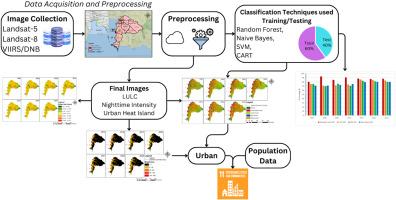Impact of Land Transition around Eastern Economic Corridor in Thailand in the context of SDG 11.3.1 using Urban Heat Islands, Nighttime Light Intensity and Machine Learning
IF 5.4
Q1 ENVIRONMENTAL SCIENCES
引用次数: 0
Abstract
The Eastern Economic Corridor (EEC) in Thailand has experienced unprecedented industrialization and urbanization since 2017 driven by the Thailand 4.0 initiative. This has resulted in complex land transitions contributing to increase Urban Heat Island (UHI) and changes in Land Use Dynamics (LUD). The aim of this study is to use geospatial data analytics to examine LUD, its impact on UHI and the trend of Land Use Efficiency (LUE: SDG Indicator 11.3.1) from 1995 to 2023. We used Landsat data to analyse LUD using Naive Bayes (NB), Support Vector Machine (SVM), Classification and Regression Trees (CART), and Random Forest (RF) optimizing the classification accuracy. The optimal features combined with population data, were utilized to estimate LUE between 1995 and 2023 at 5-year intervals. Additionally, VIIRS satellite data was employed to map nighttime light intensity, providing insights into nocturnal activities. The findings indicate that built-up areas have increased from 21.17% to 32.39% over the past 28 years, revealing changing patterns of LUD. The LUD is disproportionate with respect to population growth, resulting in dynamic LUE values: 1 (1995–2000), 0.6 (2000–2005), 3.3 (2005–2010), 0.7 (2010–2015), 0.2 (2015–2020), and 1.4 (2020–2023). The study suggests that there has been a rise in UHI effects due to rapid urbanization and industrialization, evidenced by increase in temperature 12.8 °C–14.48 °C (minimum) and 38.52 °C–43.85 °C (Maximum) between 1995 and 2023. The results of this study can assist in directing urban development projects in Thailand's EEC region by providing insight into urban growth trends, LUE, and environmental implications.

在可持续发展目标 11.3.1 的背景下,利用城市热岛、夜间光照强度和机器学习分析泰国东部经济走廊周边土地转型的影响
自 2017 年以来,在泰国 4.0 计划的推动下,泰国东部经济走廊(EEC)经历了前所未有的工业化和城市化。这导致了复杂的土地过渡,加剧了城市热岛(UHI)和土地利用动态(LUD)的变化。本研究的目的是利用地理空间数据分析来研究土地利用动态、其对 UHI 的影响以及 1995 年至 2023 年的土地利用效率(LUE:可持续发展目标指标 11.3.1)趋势。我们利用大地遥感卫星数据,使用奈非贝叶斯(NB)、支持向量机(SVM)、分类回归树(CART)和随机森林(RF)分析 LUD,优化分类精度。最佳特征与人口数据相结合,用于估算 1995 年至 2023 年间每 5 年的土地利用效率。此外,还利用 VIIRS 卫星数据绘制了夜间光照强度图,以深入了解夜间活动。研究结果表明,在过去 28 年中,建筑密集区从 21.17% 增加到 32.39%,揭示了 LUD 模式的变化。LUD 与人口增长不成比例,导致 LUE 值不断变化:1(1995-2000 年)、0.6(2000-2005 年)、3.3(2005-2010 年)、0.7(2010-2015 年)、0.2(2015-2020 年)和 1.4(2020-2023 年)。研究表明,由于城市化和工业化的快速发展,UHI效应有所上升,1995年至2023年期间气温上升了12.8 °C-14.48°C(最低气温)和38.52 °C-43.85°C(最高气温)。本研究的结果有助于深入了解城市增长趋势、土地利用效率和环境影响,从而指导泰国东欧经济区的城市发展项目。
本文章由计算机程序翻译,如有差异,请以英文原文为准。
求助全文
约1分钟内获得全文
求助全文
来源期刊

Environmental and Sustainability Indicators
Environmental Science-Environmental Science (miscellaneous)
CiteScore
7.80
自引率
2.30%
发文量
49
审稿时长
57 days
 求助内容:
求助内容: 应助结果提醒方式:
应助结果提醒方式:


